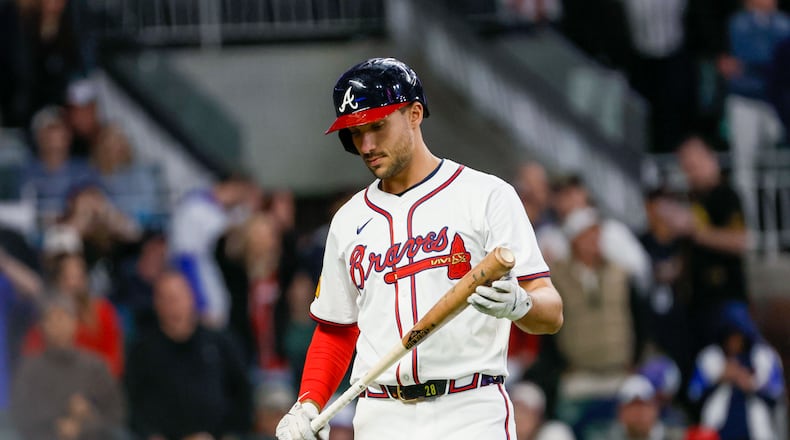Apparently, all of the Braves fans who are convinced that they jinx their team when they watch them on television were onto something.
Liberated from the viewership of Comcast subscribers, who naively believed that a company that trumpets how deeply it cares about its customers actually would care about its customers (as it eked out $15.4 billion in profit in 2023), the Braves broke out of a mini-slump against the Mariners on Wednesday afternoon.
With superstitious grandmas disconnected from Bally Sports and their beloved Braves, the slumping trio of Ronald Acuña Jr, Austin Riley and Matt Olson sprung to life and frolicked around the base paths, combining for five hits, three runs and four RBIs in the 5-2 win over Seattle.
All the Braves need now is to convince Comcast to get in carriage disputes with postseason broadcasters Fox, TBS and ESPN and they can start sizing themselves for World Series rings.
You heard it here first.
A word, though. There are more grave injustices, but it is ridiculous that MLB, Comcast and Diamond Sports Group (Bally’s parent company) have allowed this to happen. It is a transaction in which all of the entities involved deserve criticism for a lack of foresight and a surplus of avarice. MLB should know better than to give fans the opportunity to try life without regularly watching baseball.
But to get back to the Braves, the first month (and change) has been peculiar. Even as the Braves have raced to a 20-9 record, best in baseball, the productive threesome of Acuña, Olson and Riley have been relatively dormant, even remarkably so.
Acuña finished April hitting .246 with one home run and 35 strikeouts in 131 plate appearances. Including March, the reigning National League MVP slogged through arguably the second poorest month of his career.
Riley popped but two home runs, tying for his career-low output for a full month of play, with a .365 slugging percentage. His career average is .503. March/April was in contention for his poorest month ever.
After launching a team-record and MLB-best 54 home runs last year – one every 13.3 plate appearances – Olson finished April with three home runs, one every 41 plate appearances. It possibly was the least productive month of his career.
And yet, with the players who finished third, fourth and 14th in MLB in slugging percentage last season scuffling, the Braves finished April leading baseball in runs scored per game, held up by the likes of Marcell Ozuna, Travis d’Arnaud and Ozzie Albies.
But what gives with Olson, Riley and Acuña?
Olson and Riley’s numbers indicate that they’re largely suffering from bad luck. According to Fangraphs, Riley’s barrel percentage (a barrel is a ball hit with exit velocity and launch angle comparable to hit types that have resulted in a batting average of at least .500 and a slugging percentage of 1.500) actually is a tick higher than last season (14% to 13.9%), and his hard-hit percentage (balls hit with an exit velocity of at least 95 mph) also is higher than 2023 (50% to 48.8%), when he ranked top 10 in the National League in home runs, total bases, slugging percentage, run and hits.
Olson’s barrel percentage is slightly lower than his rate from last season (16.4% down to 13.3%), but his hard-hit percentage (58.7%) ranked third in baseball after Wednesday’s games.
Consider this: In the past two seasons, there have been 13 players who finished the season with a hard-hit rate of 50% or better and a launch angle of 12 degrees or higher (including Olson both years). All 13 had a slugging percentage of .424 or higher, eight were .500 or better and five slugged .604 or better. Olson, who is at .383, seems due for a correction.
A similar bump would seem impending for Riley and his slugging percentage of .387, whose career slugging percentage is .503.
The case is more peculiar for Acuña, who through Wednesday was hitting .252 and slugging .322. His career rates are .290 and .528, respectively.
Through Wednesday’s game, he was recording barrels at an 7.8% rate, well below his career average of 14.3%.
His strikeout rate was 27.9%, more than double his 11.4% from last year and above his career average of 22.2%.
In short, he has been putting the ball in play less frequently than normal and not hitting it as solidly when he has. He also has hit fly balls far less than he has in his career to this point.
The prevailing thought has been that he is trying to regain his timing after he missed time during spring training to care for soreness in his surgically repaired right knee.
Whatever the reason, he certainly would seem a player worth waiting to come around. The power decline and the strikeout rate are confounding, but this might be encouraging to Braves fans: His BABIP (batting average on balls in play, if you must ask) was .368 through Wednesday. That’s well above his career average (.335) and his average from his MVP season a year ago (.338).
Perhaps their offensive exuberance displayed Wednesday will continue with the weekend road series against the Dodgers that starts Friday. Either way, Acuña, Riley and Olson aren’t the only players struggling.
Overall, the MLB slugging percentage through April 30 was .385, which was 20 points lower than the average for March/April in 2023 and also the second lowest since 1992.
Further, there is some data, along with anecdotal evidence, to suggest that the ball isn’t as lively as it was last year. For example, on fly balls hit with a launch angle between 25 and 35 degrees with an exit velocity of at least 100 mph, 10.4% were projected to have traveled 425 feet or more, according to Statcast.
It was 12.7% in March/April last year and 16.4% in March/April in 2019, the year when four teams surpassed the previous MLB record for home runs in a season.
That’s a lot of numbers to digest. In short, Acuña, Riley and Olson probably all need a little more time. It’s not quite time to frantically mash the panic button.
Maybe all it will take is the continued involuntary non-watching.
Thanks, Comcast.
About the Author
Keep Reading
The Latest
Featured


